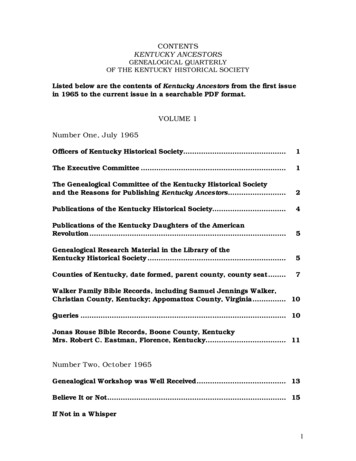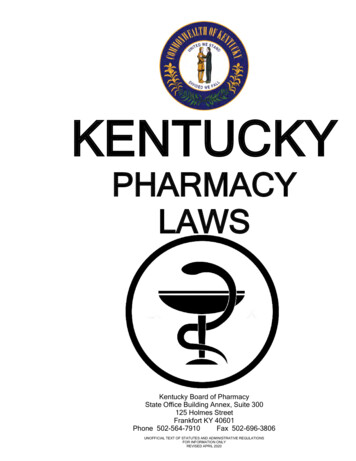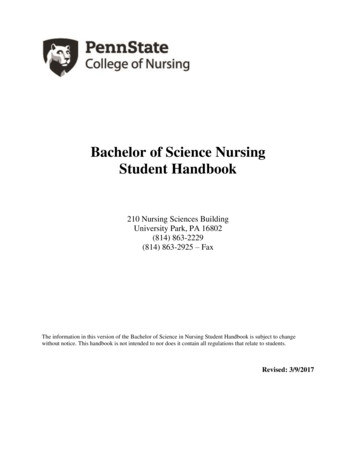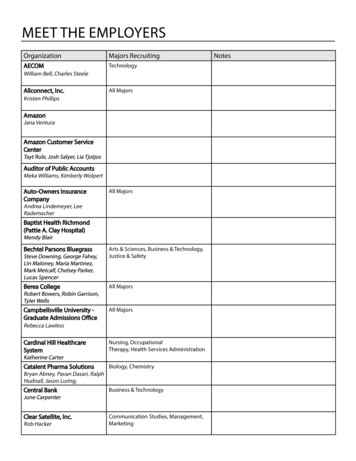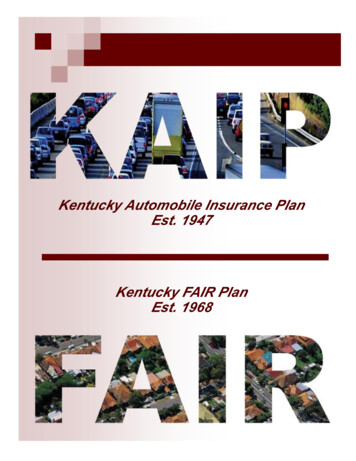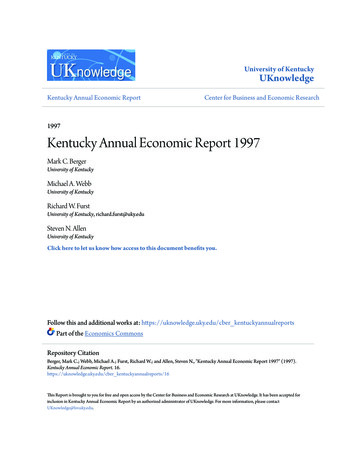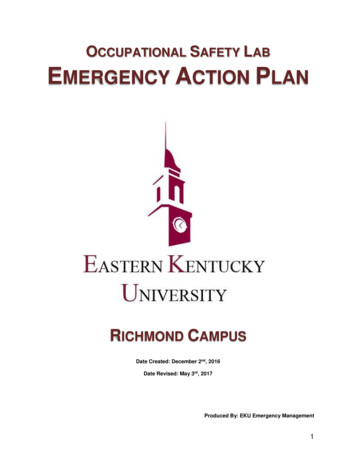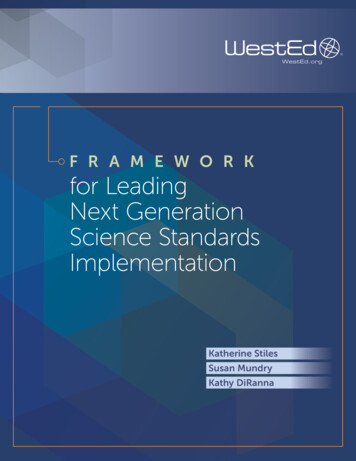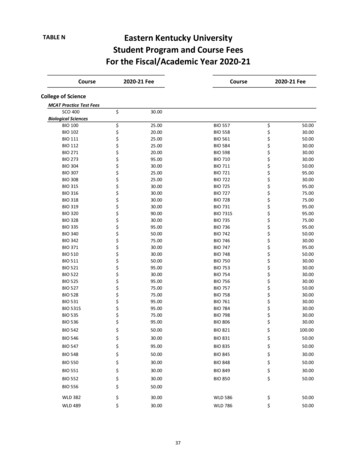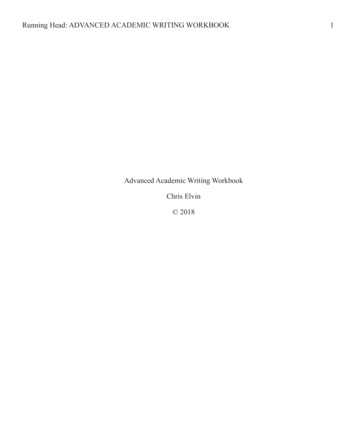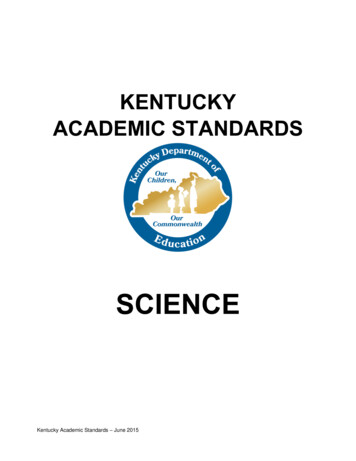
Transcription
KENTUCKYACADEMIC STANDARDSSCIENCEKentucky Academic Standards – June 2015
Kentucky Department of EducationEducation GoalsThese capacity and goal statements of the Kentucky Education Reform Act of 1990, as found inKentucky Revised Statute (KRS) 158.645 and KRS 158.6451, are the basis for instructionalprograms in Kentucky public schools. All students shall have the opportunity to acquire thefollowing capacities and learning goals: Communication skills necessary to function in a complex and changing civilizationKnowledge to make economic, social and political choicesUnderstanding of governmental processes as they affect the community, the state andthe nationSufficient self-knowledge and knowledge of their mental health and physical wellnessSufficient grounding in the arts to enable each student to appreciate their cultural andhistorical heritageSufficient preparation to choose and pursue their life’s work intelligentlySkills to enable students to compete favorably with students in other states and otherparts of the worldFurthermore, schools shall expect a high level of achievement from all students. develop their students’ abilities to:o use basic communication and mathematics skills for purposes and situations theyo will encounter throughout their liveso apply core concepts and principles from mathematics, science, arts and humanities,o social studies, English/language arts, health, mathematics, practical living, including,o physical education, to situations they will encounter throughout their liveso become self-sufficient individualso become responsible members of a family, work group or community as well as ano effective participant in community serviceo think and solve problems in school situations and in a variety of situations they willo encounter in lifeo connect and integrate experiences and new knowledge from all subject matter fieldso with what students have previously learned and build on past learning experiences too acquire new information through various media sources increase student attendance ratesreduce dropout and retention ratesreduce physical and mental health barriers to learningbe measured on the proportion of students who make a successful transition to work,postsecondary education and the militaryKentucky Academic Standards – June 20151
Kentucky Department of EducationLegal BaseThe following Kentucky Revised Statutes (KRS) and Kentucky Administrative Regulations(KAR) provide a legal base for this publication:KRS 156:160 Promulgation of administrative regulations by the Kentucky Board ofEducationWith the advice of the Local Superintendents Advisory Council, the Kentucky Board ofEducation shall promulgate administrative regulations establishing standards that public schooldistricts shall meet in student, program, service and operational performance. These regulationsshall comply with the expected outcomes for students and schools set forth in KRS 158:6451.Administrative regulations shall be promulgated for: Courses of study for the different grades and kinds of common schools; andThe minimum requirements for high school graduation.704 KAR 3:305Minimum high school graduation requirementsThis administrative regulation establishes the minimum high school graduation requirementsnecessary for entitlement to a public high school diploma, including the requirements for thegraduating class of 2012.704 KAR 3:303Required Kentucky Academic StandardsThis administrative regulation adopts into law the Kentucky Academic Standards February2010.Kentucky Academic Standards – June 20152
Kentucky Department of EducationPRIMARYSCIENCEKentucky Academic Standards – Primary Science136
Kentucky Department of EducationThe Kentucky Academic Standards for Science are written as a set of performance expectations that areassessable statements of what students should know and be able to do. An underlying assumption of thesestandards is that all students should be held accountable for demonstrating their achievement of allperformance expectations. A coherent and complete view of what students should be able to do comes whenthe performance expectations are viewed in tandem with the contents of the foundation boxes that lie justbelow the performance expectations. These three boxes include the practices, core disciplinary ideas, andcrosscutting concepts, derived from the National Research Council’s Framework for K12Science Education that were used to construct this set of performance expectations.Science and Engineering Practices. The blue box on the left includes just the science and engineeringpractices used to construct the performance expectations in the box above. These statements are derived fromand grouped by the eight categories detailed in the Framework to further explain the science and engineeringpractices important to emphasize in each grade band. Most sets of performance expectations emphasize onlya few of the practice categories; however, all practices are emphasized within a grade band.Disciplinary Core Ideas (DCIs). The orange box in the middle includes statements that are taken from theFramework about the most essential ideas in the major science disciplines that all students should understandduring 13 years of school. Including these detailed statements was very helpful to the writing team as theyanalyzed and “unpacked” the disciplinary core ideas and sub‐ideas to reach a level that is helpful in describingwhat each student should understand about each sub‐idea at the end of grades 2, 5, 8, and 12. Although theyappear in paragraph form in the Framework, here they are bulleted to be certain that each statement is distinct.Crosscutting Concepts. The green box on the right includes statements derived from the Framework’s list ofcrosscutting concepts, which apply to one or more of the performance expectations in the box above. Mostsets of performance expectations limit the number of crosscutting concepts so as focus on those that arereadily apparent when considering the DCIs; however, all are emphasized within a grade band. Aspects of theNature of Science relevant to the standard are also listed in this box, as are the interdependence of scienceand engineering, and the influence of engineering, technology, and science on society and the natural world.Connection BoxesThree Connection Boxes, below the Foundation Boxes, are designed to support a coherent vision of thestandards by showing how the performance expectations in each standard connect to other performanceexpectations in science, as well as to the KAS standards in Mathematics and English/Language Arts. Thethree boxes include: Connections to other DCIs in this grade level or band. This box contains the names of science topics inother disciplines that have related disciplinary core ideas at the same grade level. For example, bothPhysical Science and Life Science performance expectations contain core ideas related toPhotosynthesis, and could be taught in relation to one another. Articulation of DCIs across grade levels. This box contains the names of other science topics that either1) provide a foundation for student understanding of the core ideas in this set of performanceexpectations (usually at prior grade levels) or 2) build on the foundation provided by the core ideas inthis set of performance expectations (usually at subsequent grade levels).Kentucky Academic Standards – Primary Science137
Kentucky Department of Education Connections to the Kentucky Academic Standards in mathematics and English/Language Arts. Thisbox contains the coding and names of pre‐requisite or co-requisite Kentucky Academic Standards inEnglish Language Arts & and Literacy and Mathematics that align to the performance expectations. Aneffort has been made to ensure that the mathematical skills that students need for science were taughtin a previous year where possible.Kentucky Academic Standards – Primary Science138
Kentucky Department of EducationK. Forces and Interactions: Pushes and PullsK. Forces and Interactions: Pushes and PullsStudents who demonstrate understanding can:K-PS2-1. Plan and conduct an investigation to compare the effects of different strengths or differentdirections ofpushes and pulls on the motion of an object. [Clarification Statement: Examples of pushes or pulls could include a stringattached to an object being pulled, a person pushing an object, a person stopping a rolling ball, and two objects colliding and pushingeach other.] [Assessment Boundary: Assessment is limited to different relative strengths or different directions, but not both at thetime. Assessment does not include non-contact pushes or pulls such as those produced by magnets.]onsameK-PS2-2.Analyze data to determine if a design solution works as intended to change the speed or direction of an objectwith a push or a pull.* [Clarification Statement: Examples of problems requiring a solution could include having a marble or otherobject move a certain distance, follow a particular path, and knock down other objects. Examples of solutions could include tools suchas a ramp to increase the speed of the object and a structure that would cause an object such as a marble or ball to turn.][Assessment Boundary: Assessment does not include friction as a mechanism for change in speed.]The performance expectations above were developed using the following elements from the NRC document A Framework for K-12 ScienceEducation:Science and Engineering PracticesDisciplinary Core IdeasCrosscutting ConceptsPlanning and Carrying Out InvestigationsPlanning and carrying out investigations to answerquestions or test solutions to problems in K–2 builds onprior experiences and progresses to simpleinvestigations, based on fair tests, which provide data tosupport explanations or design solutions. With guidance, plan and conduct an investigationin collaboration with peers. (K-PS2-1)Analyzing and Interpreting DataAnalyzing data in K–2 builds on prior experiences andprogresses to collecting, recording, and sharingobservations. Analyze data from tests of an object or tool todetermine if it works as intended. -----------Connections to Nature of SciencePS2.A: Forces and Motion Pushes and pulls can have different strengthsand directions. (KPS2-1),(K-PS2-2) Pushing or pulling on an object can change thespeed or direction of its motion and can start orstop it. (K-PS2-1),(K-PS2-2)PS2.B: Types of Interactions When objects touch or collide, they push on oneanother and can change motion. (K-PS2-1)PS3.C: Relationship Between Energy and Forces A bigger push or pull makes things speed up orslow down more quickly. (secondary to K-PS2-1)ETS1.A: Defining Engineering Problems A situation that people want to change or createcan be approached as a problem to be solvedthrough engineering. Such problems may havemany acceptable solutions. (secondary to KPS22)Cause and Effect Simple tests can be designed togather evidence to support orrefute student ideas aboutcauses. (K-PS2-1),(K-PS2-2)Scientific Investigations Use a Variety of Methods Scientists use different ways to study the world. (KPS2-1)Connections to other DCIs in kindergarten: K.ETS1.A (K-PS2-2); K.ETS1.B (K-PS2-2)Articulation of DCIs across grade-levels: 2.ETS1.B (K-PS2-2); 3.PS2.A (K-PS2-1),(K-PS2-2); 3.PS2.B (K-PS2-1); 4.PS3.A (K-PS2-1); 4.ETS1.A (KPS2-2)Kentucky Academic Standards Connections:ELA/Literacy –RI.K.1With prompting and support, ask and answer questions about key details in a text. (K-PS2-2)W.K.7Participate in shared research and writing projects (e.g., explore a number of books by a favorite author and express opinions aboutthem).(K-PS2-1)SL.K.3Ask and answer questions in order to seek help, get information, or clarify something that is not understood. (K-PS2-2)Mathematics –MP.2Reason abstractly and quantitatively. (K-PS2-1)K.MD.A.1 Describe measurable attributes of objects, such as length or weight. Describe several measurable attributes of a single object. (K-PS2-1)K.MD.A.2 Directly compare two objects with a measurable attribute in common, to see which object has “more of”/”less of” the attribute, anddescribethe difference. (K-PS2-1)*The performance expectations marked with an asterisk integrate traditional science content with engineering through a Practice or Disciplinary Core Idea.The section entitled “Disciplinary Core Ideas” is reproduced verbatim from A Framework for K-12 Science Education: Practices, Cross-Cutting Concepts, and Core Ideas.Integrated and reprinted with permission from the National Academy of Sciences.Kentucky Academic Standards – Primary Science139
Kentucky Department of EducationK. Interdependent Relationships in Ecosystems: Animals, Plants, and Their EnvironmentK. Interdependent Relationships in Ecosystems: Animals, Plants, and Their EnvironmentStudents who demonstrate understanding can:K-LS1-1.Use observations to describe patterns of what plants and animals (including humans) need to survive.[Clarification Statement: Examples of patterns could include that animals need to take in food but plants do not; the different kinds of food needed bydifferent types of animals; the requirement of plants to have light; and that all living things need water.]K-ESS2-2.Construct an argument supported by evidence for how plants and animals (including humans) can change theenvironment to meet their needs. [Clarification Statement: Examples of plants and animals changing their environment could include asquirreldigs in the ground to hide its food and tree roots can break concrete.]K-ESS3-1.Use a model to represent the relationship between the needs of different plants or animals (includinghumans) and the places they live. [Clarification Statement: Examples of relationships could include that deer eat buds and leaves, therefore,they usually live in forested areas, and grasses need sunlight so they often grow in meadows. Plants, animals, and their surroundings make up a system.]K-ESS3-3.Communicate solutions that will reduce the impact of humans on the land, water, air, and/or other living thingsin the local environment.* [Clarification Statement: Examples of human impact on the land could include cutting trees to produce paper andusingresources to produce bottles. Examples of solutions could include reusing paper and recycling cans and bottles.]The performance expectations above were developed using the following elements from the NRC document A Framework for K-12 Science Education:Science and Engineering PracticesDisciplinary Core IdeasCrosscutting ConceptsDeveloping and Using ModelsModeling in K–2 builds on prior experiences and progresses to includeusing and developing models (i.e., diagram, drawing, physical replica,diorama, dramatization, or storyboard) that represent concrete events ordesign solutions. Use a model to represent relationships in the natural world. (K-ESS31)Analyzing and Interpreting DataAnalyzing data in K–2 builds on prior experiences and progresses tocollecting, recording, and sharing observations. Use observations (firsthand or from media) to describe patterns in the natural world in order to answer scientific questions. (KLS1-1)Engaging in Argument from EvidenceEngaging in argument from evidence in K–2 builds on prior experiences andprogresses to comparing ideas and representations about the natural anddesigned world(s). Construct an argument with evidence to support a claim. (K-ESS2-2)Obtaining, Evaluating, and Communicating InformationObtaining, evaluating, and communicating information in K–2 builds on priorexperiences and uses observations and texts to communicate newinformation. Communicate solutions with others in oral and/or written forms usingmodels and/or drawings that provide detail about scientific ideas. -----Connections to Nature of ScienceScientific Knowledge is Based on Empirical Evidence Scientists look for patterns and order when making observations aboutthe world. (K-LS1-1)LS1.C: Organization for Matter and EnergyFlow in Organisms All animals need food in order to live andgrow. They obtain their food from plantsor from other animals. Plants need waterand light to live and grow. (K-LS1-1)ESS2.E: Biogeology Plants and animals can change theirenvironment. (K-ESS2-2)ESS3.A: Natural Resources Living things need water, air, andresources from the land, and they live inplaces that have the things they need.Humans use natural resources foreverything they do. (K-ESS3-1)ESS3.C: Human Impacts on Earth Systems Things that people do to live comfortablycan affect the world around them. Butthey can make choices that reduce theirimpacts on the land, water, air, and otherliving things.(secondary to K-ESS2-2),(K-ESS3-3)ETS1.B: Developing Possible Solutions Designs can be conveyed throughsketches, drawings, or physical models.These representations are useful incommunicating ideas for a problem’ssolutions to other people.(secondary toK-ESS3-3)Patterns Patterns in the natural andhuman designed world canbe observed and used asevidence. (K-LS1-1)Cause and Effect Events have causes thatgenerate observablepatterns. (K-ESS3-3)Systems and System Models Systems in the natural anddesigned world have partsthat work together. (KESS2-2),(K-ESS3-1)Connections to other DCIs in kindergarten: K.ETS1.A (K-ESS3-3)Articulation of DCIs across grade-levels: 1.LS1.A (K-LS1-1),(K-ESS3-1); 2.LS2.A (K-LS1-1); 2.ETS1.B (K-ESS3-3); 3.LS2.C (K-LS1-1); 3.LS4.B (K-LS1-1); 4.ESS2.E (KESS2-2); 4.ESS3.A (K-ESS3-3); 5.LS1.C (K-LS1-1); 5.LS2.A (K-LS1-1),(K-ESS3-1); 5.ESS2.A (K-ESS2-2),(K-ESS3-1); 5.ESS3.C (K-ESS3-3)Kentucky Academic Standards Connections:ELA/Literacy –RI.K.1With prompting and support, ask and answer questions about key details in a text. (K-ESS2-2)W.K.1Use a combination of drawing, dictating, and writing to compose opinion pieces in which they tell a reader the topic or the name of the book they are writingabout and state an opinion or preference about the topic or book. (K-ESS2-2)W.K.2Use a combination of drawing, dictating, and writing to compose informative/explanatory texts in which they name what they are writing about and supplysome information about the topic. (K-ESS2-2),(K-ESS3-3)W.K.7Participate in shared research and writing projects (e.g., explore a number of books by a favorite author and express opinions about them). (K-LS1-1)SL.K.5Add drawings or other visual displays to descriptions as desired to provide additional detail. (K-ESS3-1)Mathematics –MP.2Reason abstractly and quantitatively. (K-ESS3-1)MP.4Model with mathematics. (K-ESS3-1)K.CCCounting and Cardinality (K-ESS3-1)K.MD.A.2Directly compare two objects with a measurable attribute in common, to see which object has “more of”/”less of” the attribute, and describe the difference. (K-LS11)*The performance expectations marked with an asterisk integrate traditional science content with engineering through a Practice or Disciplinary Core Idea.The section entitled “Disciplinary Core Ideas” is reproduced verbatim from A Framework for K-12 Science Education: Practices, Cross-Cutting Concepts, and Core Ideas.Integrated and reprinted with permission from the National Academy of Sciences.Kentucky Academic Standards – Primary Science140
Kentucky Department of EducationK. Weather and ClimateK. Weather and ClimateStudents who demonstrate understanding can:K-PS3-1.Make observations to determine the effect of sunlight on Earth’s surface.[Clarification Statement: Examples of Earth’s surfacecould include sand, soil, rocks, and water] [Assessment Boundary: Assessment of temperature is limited to relative measures such as warmer/cooler.]K-PS3-2.K-ESS2-1.ExamplesUse tools and materials to design and build a structure that will reduce the warming effect of sunlight on anarea.* [Clarification Statement: Examples of structures could include umbrellas, canopies, and tents that minimize the warming effect of the sun.]Use and share observations of local weather conditions to describe patterns over time. [Clarification Statement:of qualitative observations could include descriptions of the weather (such as sunny, cloudy, rainy, and warm); examples of quantitative observations couldinclude numbers of sunny, windy, and rainy days in a month. Examples of patterns could include that it is usually cooler in the morning than in theand the number of sunny days versus cloudy days in different months.] [Assessment Boundary: Assessment of quantitative observations limited to wholenumbers and relative measures such as warmer/cooler.]afternoonK-ESS3-2.Ask questions to obtain information about the purpose of weather forecasting to prepare for, and respond to,severe weather.* [Clarification Statement: Emphasis is on local forms of severe weather.]The performance expectations above were developed using the following elements from the NRC document A Framework for K-12 Science Education:Science and Engineering PracticesDisciplinary Core IdeasCrosscutting ConceptsAsking Questions and Defining ProblemsAsking questions and defining problems in grades K–2 builds on prior experiences andprogresses to simple descriptive questions that can be tested. Ask questions based on observations to find more information about the designedworld. (K-ESS3-2)Planning and Carrying Out InvestigationsPlanning and carrying out investigations to answer questions or test solutions to problems inK–2 builds on prior experiences and progresses to simple investigations, based on fair tests,which provide data to support explanations or design solutions. Make observations (firsthand or from media) to collect data that can be used to makecomparisons. (K-PS3-1)Analyzing and Interpreting DataAnalyzing data in K–2 builds on prior experiences and progresses to collecting, recording,and sharing observations. Use observations (firsthand or from media) to describe patterns in the natural world inorder to answer scientific questions. (K-ESS2-1)Constructing Explanations and Designing SolutionsConstructing explanations and designing solutions in K–2 builds on prior experiences andprogresses to the use of evidence and ideas in constructing evidence-based accounts ofnatural phenomena and designing solutions. Use tools and materials provided to design and build a device that solves a specificproblem or a solution to a specific problem. (K-PS3-2)Obtaining, Evaluating, and Communicating InformationObtaining, evaluating, and communicating information in K–2 builds on prior experiences anduses observations and texts to communicate new information. Read grade-appropriate texts and/or use media to obtain scientific information todescribe patterns in the natural world. ------------------------------Connections to Nature of ScienceScientific Investigations Use a Variety of Methods Scientists use different ways to study the world. (K-PS3-1)Science Knowledge is Based on Empirical Evidence Scientists look for patterns and order when making observations about the world. (KESS2-1)PS3.B: Conservation of Energyand Energy Transfer Sunlight warms Earth’ssurface. (K-PS31), (K-PS3-2)ESS2.D: Weather and Climate Weather is the combination ofsunlight, wind, snow or rain,and temperature in a particularregion at a particular time.People measure theseconditions to describe andrecord the weather and tonotice patterns over time. (KESS2-1)ESS3.B: Natural Hazards Some kinds of severe weatherare more likely than others ina given region. Weatherscientists forecast severeweather so that thecommunities can prepare forand respond to these events.(K-ESS3-2)ETS1.A: Defining and Delimitingan Engineering Problem Asking questions, makingobservations, and gatheringinformation are helpful inthinking about problems.(secondary to K-ESS3-2)Patterns Patterns in the natural worldcan be observed, used todescribe phenomena, andused as evidence. (K-ESS21)Cause and Effect Events have causes thatgenerate observablepatterns. ------------------Connections to Engineering,Technology, and Applicationsof ScienceInterdependence of Science,Engineering, and Technology People encounter questionsabout the natural worldevery day. (K-ESS3-2)Influence of Engineering,Technology, and Science onSociety and the NaturalWorld People depend on varioustechnologies in their lives;human life would be verydifferent without technology.(K-ESS3-2)Connections to other DCIs in kindergarten: K.ETS1.A (K-PS3-2),(K-ESS3-2); K.ETS1.B (K-PS3-2)Articulation of DCIs across grade-levels: 1.PS4.B (K-PS3-1),(K-PS3-2); 2.ESS1.C (K-ESS3-2); 2.ESS2.A (K-ESS2-1); 2.ETS1.B (K-PS3-2); 3.ESS2.D (K-PS3-1),(K-ESS21); 3.ESS3.B (K-ESS3-2); 4.ESS2.A (K-ESS2-1); 4.ESS3.B (K-ESS3-2); 4.ETS1.A (K-PS3-2)Kentucky Academic Standards Connections:ELA/Literacy –RI.K.1With prompting and support, ask and answer questions about key details in a text. (K-ESS3-2)W.K.7Participate in shared research and writing projects (e.g., explore a number of books by a favorite author and express opinions about them). (K-PS3-1),(K-PS3-2),(KESS2-1)SL.K.3Ask and answer questions in order to seek help, get information, or clarify something that is not understood. (K-ESS3-2)Mathematics –MP.2Reason abstractly and quantitatively. (K-ESS2-1)MP.4Model with mathematics. (K-ESS2-1),(K-ESS3-2)K.CCCounting and Cardinality (K-ESS3-2)K.CC.AKnow number names and the count sequence. (K-ESS2-1)K.MD.A.1Describe measurable attributes of objects, such as length or weight. Describe several measurable attributes of a single object. (K-ESS2-1)K.MD.A.2Directly compare two objects with a measurable attribute in common, to see which object has “more of”/”less of” the attribute, and describe the difference. (K-PS3-1),(KPS3-2)K.MD.B.3Classify objects into given categories; count the number of objects in each category and sort the categories by count. (K-ESS2-1)*The performance expectations marked with an asterisk integrate traditional science content with engineering through a Practice or Disciplinary Core Idea.The section entitled “Disciplinary Core Ideas” is reproduced verbatim from A Framework for K-12 Science Education: Practices, Cross-Cutting Concepts, and Core Ideas.Integrated and reprinted with permission from the National Academy of Sciences.Kentucky Academic Standards – Primary Science141
Kentucky Department of Education1. Waves: Light and Sound1. Waves: Light and SoundStudents who demonstrate understanding can:1-PS4-1. Plan and conduct investigations to provide evidence that vibrating materials can make sound and that sound canmake materials vibrate. [Clarification Statement: Examples of vibrating materials that make sound could include tuning forks and plucking a stretchedstring. Examples of how sound can make matter vibrate could include holding a piece of paper near a speaker making sound and holding an object near avibrating tuning fork.]1-PS4-2.Make observations to construct an evidence-based account that objects can be seen only when illuminated.[Clarification Statement: Examples of observations could include those made in a completely dark room, a pinhole box, and a video of a cave explorer with aflashlight. Illumination could be from an external light source or by an object giving off its own light.]1-PS4-3.Plan and conduct an investigation to determine the effect of placing objects made with different materials in the pathof a beam of light. [Clarification Statement: Examples of materials could include those that are transparent (such as clear plastic), translucent (such aswax paper), opaque (such as cardboard), and reflective (such as a mirror).] [Assessment Boundary: Assessment does not include the speed of light.]1-PS4-4.Use tools and materials to design and build a device that uses light or sound to solve the problem of communicatingover a distance.* [Clarification Statement: Examples of devices could include a light source to send signals, paper cup and string “telephones,” and a patternof drum beats.] [Assessment Boundary: Assessment does not include technological details for how communication devices work.]The performance expectations above were developed using the following elements from the NRC document A Framework for K-12 Science Education:Science and Engineering PracticesDisciplinary Core IdeasPlanning and Carrying Out InvestigationsPS4.A: Wave PropertiesPlanning and carrying out investigations to answer questions Sound can make matter vibrate, andor test solutions to problems in K–2 builds on prior experiencesvibrating matter can make sound. (1-PS4and progresses to simple investigations, based on fair tests,1)which provide data to support explanations or design solutions. Plan and conduct investigations collaboratively to produce PS4.B: Electromagnetic Radiationdata to serve as the basis for evidence to answer a Objects can be seen if light is available toquestion. (1-PS4-1),(1-PS4-3)illuminate them or if they give off their ownlight. (1-PS4-2)Constructing Explanations and Designing Solutions Some materials allow light to pass throughConstructing explanations and designing solutions in K–2them, others allow only some light throughbuilds on prior experiences and progresses to the use ofand others block all the light and create aevidence and ideas in constructing evidence-based accountsdark shadow on any surface beyond them,of natural phenomena and designing solutions.where the light cannot reach. Mirrors can Make observations (firsthand or from media) to constructbe used to redirect a light beam.an evidence-based account for natural phenomena (1(Boundary: The idea that light travels fromPS4-2)place to place is developed throughexperiences with light sources, mirrors, and Use tools and materials provided to design a device thatsolves a specific problem. (1-PS4-4)shadows, but no attempt is made -------discuss the speed of light.) (1-PS4-3)Connections to Nature of SciencePS
Framework for K12 Science Education . that were used to construct this set of performance expectations. Science and Engineering Practices. The blue box on the left includes just the science and engineering practices used to construct the performance expecta
